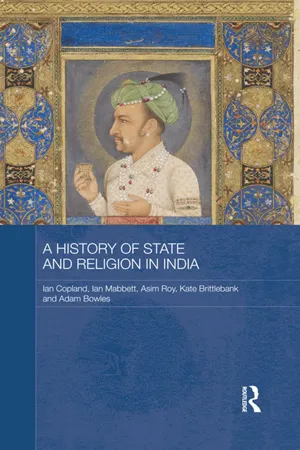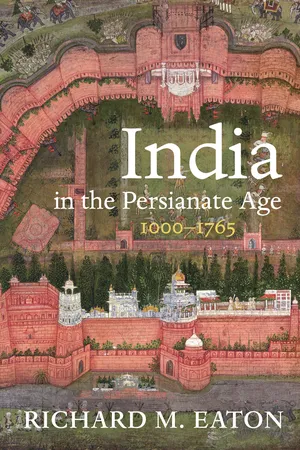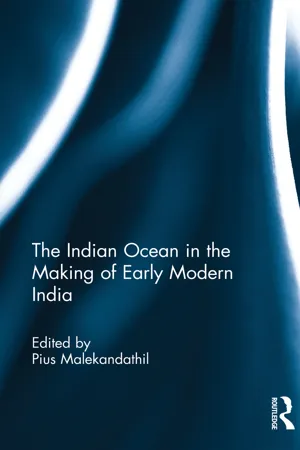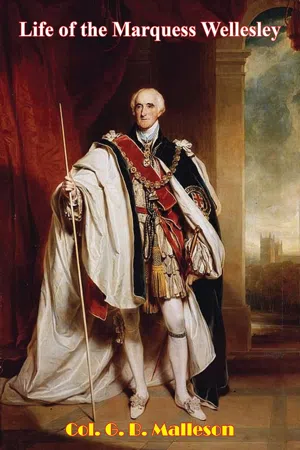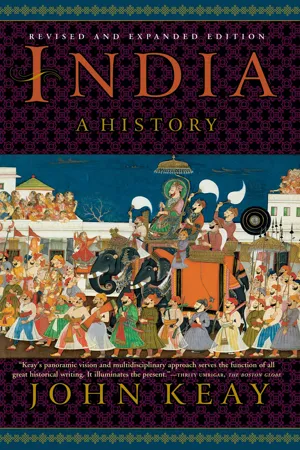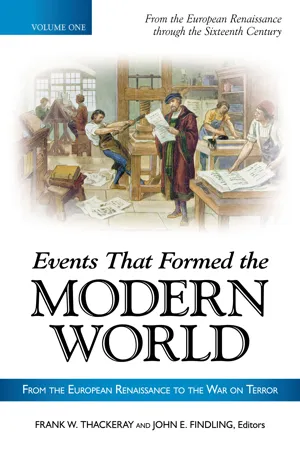History
Mughal Maratha Wars
The Mughal Maratha Wars were a series of conflicts between the Mughal Empire and the Maratha Confederacy in India during the 17th and 18th centuries. These wars were characterized by power struggles, territorial disputes, and attempts to assert dominance over the Indian subcontinent. The Marathas ultimately emerged victorious, weakening the Mughal Empire and establishing their own regional power.
Written by Perlego with AI-assistance
Related key terms
Related key terms
1 of 4
Related key terms
1 of 3
7 Key excerpts on "Mughal Maratha Wars"
- Kaushik Roy(Author)
- 2011(Publication Date)
- Routledge(Publisher)
5 The Maratha Confederacy
Armies, economy and warfare
Seventeenth-century Maharashtra was dominated by the high caste landlords (patel s and desais ). The marginal landlords sold their service to Bijapur and Golkunda kingdoms. During the second half of the seventeenth century, the Mughals intervened on a large scale in Deccan. Taking advantage of the tripolar struggle, one Maratha warlord, Shahji, became autonomous. His son Shivaji founded a kingdom in Maharashtra. His support base comprised low caste kunbi peasants. Towards the end of seventeenth century, the Mughals had absorbed Bijapur and Golkunda and turned against the Marathas. Aurangzeb, the last great Mughal, continued to fight Shivaji and his son Sambhaji until his death in 1707. After Aurangzeb’s death when the bulk of the Mughal Army left Deccan for north India, the Mughals released Sahu, Sambhaji’s son. Civil War broke out among the Marathas and finally Sahu emerged successful.1During the reign of Shivaji’s grandson Sahu (18 May 1682–1749, King from 1707 onwards), the Peshwa became the principal power centre in the Maratha Empire. The first Peshwa was Balaji Viswanath (17 November 1713–2 April 1720), who was succeeded by Baji Rao I; and he, in turn, was succeeded by Balaji Baji Rao. In 1749, Shivaji’s grandson Sahu died and then Balaji Baji Rao took full control.2Under the three successive Peshwa s, breakneck expansion of the Maratha power occurred in both central and north India. From the mid-eighteenth century, the Maratha polity started getting fractured and it became a confederacy. The Pune durbar under the Peshwa controlled the Swarajya (Maharashtra) and parts of Karnatak. The other independent power centres under the powerful sirdar s were Gaikwad at Baroda, Ranoji Sindia (the founder of Sindia appanage who died 1745) at Gwalior, Malhar Rao Holkar at Indore and Bhonsle at Nagpur. These Maratha sirdar s obeyed the de jure authority of the Peshwa . The centrifugal tendencies in the Maratha Confederacy increased after the Third Panipat as the Peshwa- eBook - ePub
- Ian Copland, Ian Mabbett, Asim Roy, Kate Brittlebank, Adam Bowles(Authors)
- 2013(Publication Date)
- Routledge(Publisher)
20The place of religion in the turbulent politics of eighteenth-century India remains a valid object of inquiry; but broad generalisations will no longer suffice. A more nuanced approach is called for. Since we cannot hope to provide that, in the space we have available, for all the regimes that contested for power during these hundred odd years, in the rest of the chapter we focus on just one, the Maratha Kingdom/Confederacy. First, we look at a range of late seventeenth- and eighteenth-century literary constructions of state-level political conflicts, generated in Maratha literary, often courtly, contexts. We then investigate some instances of Maratha governmental agencies intervening decisively (for better or worse) in matters that can be construed in some sense as ‘religious’. Finally, picking up on the issue that concluded Chapter 7 , we examine the possibility that there may have been continuities as between inter-sectarian conflicts and conflicts (expressed or actual) between groups aligning along broader corporate identities and competing for access to political and economic rights. This case study cannot speak for the whole, but it has the potential to tell us much, since the Maratha state was arguably the most significant polity of the age.The literary contours of religious discord
The emergence of terms of self-reference is, of course, a very important aspect of the process of the formation of corporate identity. Yet this is not the only way in which notions of group identity, and the sentiments and symbolic registers that underpin such notions, can be expressed and drawn upon in order to ideologically sustain political, territorial or military causes. If the gradual adoption in pre-modern India of ‘Hindu’ as an endonym typically (but not exclusively) occurred within contexts where the group was defined by being weighed against another sodality religiously and culturally codified as other, group-internal evocations of common sentiments underpinning corporate identities were not necessarily consistently marked by a recurring nomenclature, but rather through cultural practices and symbolic codes having deep historical resonances. - eBook - ePub
India in the Persianate Age
1000–1765
- Richard M. Eaton(Author)
- 2019(Publication Date)
- University of California Press(Publisher)
Later that year the Persian warlord Nadir Shah marched through the Khyber Pass with 150,000 cavalry, defeated a much larger Mughal army and sacked a supine, defenceless Delhi. Like Timur more than three centuries earlier, he chose not to remain in India, returning to Iran with caravans laden with looted gold, silver and jewellery worth 1.5 million rupees, including the famed Koh-i-Noor, and, not least, Shah Jahan’s priceless Peacock Throne. With such celebrated symbols of imperial glory for ever stripped from Indian soil, the Marathas were suddenly awakened to the reality that the Mughals were not, in fact, their enemy. Rather, they now saw the house of Babur as the key symbol of Indian sovereignty, to be defended from foreign invaders at all costs. To this end, Baji Rao proposed that all the powers of north India join a confederation to protect India’s Timurid dynasty, making the Peshwa almost resemble a proto-nationalist figure. For several decades, a cornerstone of Maratha policy was to pose as the Mughals’ truest defenders, at least at the imperial level.At the grass-roots level, however, the Peshwa’s sardar s continued to chip away at Mughal sovereignty. In older provinces such as Malwa, Khandesh or Gujarat, independent bands of up to 5,000 light cavalry would raid and plunder the countryside, avoiding pitched battles with imperial armies.20 Mughal authorities in these provinces might still control major fortified urban centres, but they were no longer drawing revenue from their rural hinterlands. The transition from Mughal to Maratha authority between the 1730s and 1750s was therefore barely perceptible, not only because it occurred so gradually, but also because the Marathas continued to use Mughal administrative procedures and practices, mitigating a sense of a political rupture.21 Yet Maratha rule was patchy and irregular across much of central India in those decades, some regions being fully administered by the Peshwa’s men and others only thinly administered, and populated by recalcitrant zamindar s who managed to defy Maratha authority from behind walled strongholds.Under Baji Rao’s son Nana Saheb (r. 1740–61), Maratha conquests briefly encompassed almost all of north India. These included six devastating raids on Bengal between 1741 and 1751. But, by the late 1750s, the Marathas had become more than simply the guarantors of Mughal authority. As their strategic objective shifted from defending their mountainous homeland to plundering and then governing north India’s wide plains, they also adopted Mughal military culture. In the days of Shivaji, Maratha forces had consisted of small, mobile bands of swift cavalry and lightly armed infantry, appropriate for the sort of guerrilla warfare that Malik Ambar had pioneered in the Ahmadnagar sultanate’s final decades. By contrast, the great Maratha armies of the 1740s and 1750s, which numbered up to 40,000 mainly uniformed infantry, lumbered across the land like moving cities, moving no faster than the bullocks that dragged their long trains of baggage and heavy artillery. By mid-century, too, the Maratha ruling elite, owing to its prolonged exposure to north India’s ways, had acquired a taste for the refinements of Mughal culture. This in turn created a demand in urban Maharashtra for Kashmiri shawls, Bengali silks, ivory craft, metalwork in silver, copper and brass and so on, while administrators in the Maratha capital in Satara, and after 1750 in Pune, patronized north Indian styles of painting and music.22 - Pius Malekandathil(Author)
- 2016(Publication Date)
- Routledge(Publisher)
60Military Personnel: Immigrant Elite, Military Slaves, and Armed Peasants
In this section, I shall briefly discuss a few issues regarding the world of military personnel of different polities of early modern South Asia by referring to two aspects of this world—the military labour market of north India on the one hand and immigrant politico-military elite and military slaves on the other.Dirk Kolff made a breakthrough in the historiography of early modern warfare by throwing light on the sector of military labour in the Indian subcontinent. For the first time, he argued that a great portion of the north Indian peasantry was in fact perpetually armed, and elaborated how this complicated the relationship between this peasantry and the empires of north India. During the off season of cultivation, these armed peasants would also hire out their services to different polities and serve in the infantry as foot-archers. In the late sixteenth century, several communities arose, mainly from the Middle Gangetic Basin, like Baksariyas and Purbiyas, who specialized in musketry and thus became much valued in the military labour market. By virtue of this community-based martial specialization, they were able to find employment in the armies of several polities of north India, including several Rajput states and the Sultanates of Gujarat and Malwa by the mid-sixteenth century. Once the Mughal Empire extended to Gujarat and Malwa, these groups were inducted into the Mughal army. The complex relationship between the armed peasantry and the revenue-collecting state has also been addressed by Iqtidar Alam Khan. By the late seventeenth century, there were several social communities in north India who specialized in foot-musketry, like the Bahelias and Bhadurias, among others. He also points out that during the reign of Aurangzeb, the Baksariyas were the largest social group serving in the Mughal army as foot-musketeers as well as foot-archers.61- eBook - ePub
- Col. G. B. Malleson(Author)
- 2016(Publication Date)
- Normanby Press(Publisher)
CHAPTER VII. — THE MARÁTHÁ WARS. — 1802-1805. The Maráthá, Empire—Its consolidation by Mádhají Sindhiá—his death and its consequences—The treaty of Bassein—Discontent of Dáolat Ráo Sindhiá—Lord Wellesley’s military preparations—Restoration of the Peshwá by General Wellesley—Evasions of Sindhiá and the Bhonslá.—Lord Wellesley’s plan of campaign—Assaye, Argaum, and Láswárí—The Maráthás sue for peace—Inaction of Holkar—He now resolves on war—Monson’s retreat—It is avenged by General Lake—Holkar’s surrender. THE Maráthá Empire, if I may so term the five States ruled by Maráthá chiefs, with the Peshwá as their nominal head, which, at the period of which I am writing, dominated Western, Central, and North-Western India, founded in the middle of the seventeenth century by Sívájí; tending to decay under his son, Sambají; restored by the efforts of Mulhárjí Holkar and Ránojí Sindhiá; had been humbled to the dust by the complete defeat its armies sustained on the fatal field of Pánípat, at the hands of the ruler of Kábul, Ahmad Sháh Abdálí, January the 6 th, 1761. There fled, however, from that field, sorely wounded, a member of the house of Sindhiá, Mádhájí by name, who, recognised shortly afterwards as the head of that house, devoted all his intellectual power, which was extraordinary, and his energies, which were untiring, to restore to his race the influence and the position which it had lost He succeeded. In 1771, he entered Dehlí—the titular Emperor, Shah Alain, in his train—as a conqueror. In 1778, he had his first contest with the English, a contest in which not only had the Maráthás all the advantage in the field, but they forced upon their enemy the shameful and humiliating Treaty of Wárgaum (January 14 th, 1779). Warren Hastings, however, who then guided the fortunes of British India, was not the man to allow such a disgrace to pass unavenged - eBook - ePub
India
A History
- John Keay(Author)
- 2011(Publication Date)
- Grove Press(Publisher)
In the following decade other Marathas, particularly Malhar Rao Holkar of Indore and Jayappa Scindia soon of Gwalior, took advantage of succession disputes amongst the rajputs to extend their revenue claims in Rajasthan. In 1752–3 they again intervened in the chaotic affairs of Delhi and were a party to the blinding and removal of the then emperor. Further Maratha expansion saw Raghunath Rao, the brother of the peshwa Balaji Baji Rao (son of Baji Rao I), pushing into the Panjab in the wake of the Afghan withdrawal after Ahmed Shah Abdali’s plunder of Delhi in 1756. In Lahore as in Delhi, the Marathas were now major players, while far away in the Deccan a defeat of the nizam in 1760 left the peshwas at Pune secure in possession of their Maharashtrian homeland.Indeed 1760 is taken to mark ‘the zenith of Mahratta power’. Freezing the moment for all its glory, James Grant Duff, author of the classic nineteenth-century History of the Mahrattas , seems to pay unintentional homage to the imagery of those fulsome dynastic inscriptions of an earlier age.The pre-eminence to which the Mahrattas had attained was animating and glorious; their right to tribute was acknowledged on the banks of the Coleroon [the lower Kaveri in Tamil Nadu], and the Deccan horse had quenched their thirst from the waters of the Indus. The Mahratta people felt a pride in the conquests of their countrymen …19The moment was short-lived. Before the year was out the peshwa’s general, fresh from his victory over the nizam, led the main Maratha army north to meet the threat posed by the reinvading Abdali. Abdali could count on the support of fellow Afghans, like the Rohillas, and had also won over the powerful (and then still independent) Nawab of Awadh. On the other hand Holkar, the Scindia family and other Maratha chiefs dutifully joined the swelling army of the peshwa. Well equipped with artillery, and with Duff’s ‘Deccan horse’ looking especially splendid, this was the largest and most magnificent force ever assembled by the Marathas. In an age when sectarian loyalties rarely transcended political advantage, it might even have passed for a Hindu host had the hoped-for support of coreligionists like the rajputs and Jats materialised. - eBook - ePub
Events That Formed the Modern World
From the European Renaissance through the War on Terror [5 volumes]
- Frank W. Thackeray, John E. Findling, Frank W. Thackeray, John E. Findling, Frank W. Thackeray, John E. Findling(Authors)
- 2012(Publication Date)
- ABC-CLIO(Publisher)
zamindars , the local notables who remitted the land revenue, countered by leading their peasants in revolt. Now, by eroding the loyalty to the emperor that many non-Muslims had felt during the previous century, Aurangzeb’s religious policy may have begun to bear fruit. This destroyed what had been a major psychological barrier to rebellion, even under great provocation.The 88-year-old Aurangzeb died in 1707 and was succeeded by his eldest surviving son Bahadur Shah. Despite the Maratha war and the local rebellions, the Mughal Empire remained powerful, and the new emperor tried to restore order. Aurangzeb had enrolled Sambhaji’s son Shahu as a mansabdar and brought up the Maratha prince as a loyal Mughal noble; and Bahadur Shah now sought to bring the Marathas to heel by allowing Shahu to return to his homeland and take up his father’s throne. He also made peace with the Sikhs, whose guru Gobind Singh entered the imperial court. But Bahadur Shah was already 63 years old when he came to the throne, and he did not have the strength or the time to rejuvenate the empire. The Sikhs rebelled again after Gobind Singh was assassinated by a servant, and Bahadur Shah’s death in 1712 touched off power struggles among princes and courtiers and a new Maratha rising under Shahu’s prime minister. All this combined to destroy the empire that had been weakened by the war in the south. By 1750, Mughal power was a thing of the past. A member of the imperial dynasty still lived in Delhi, but India was divided among rival mansabdars who had established themselves as virtually independent regional rulers, Maratha insurgents, andAfghan invaders. The merchants of the English East India Company were about to take advantage of this political realignment by launching a process of expansion that ended a century later with the entire subcontinent under British control.Ultimately, the Mughal emperors’ quest for glory helped to destroy them. But it also gave the world some of its most beautiful buildings and paintings, fine prose and poetry in Persian and Hindi, and the bases of Indian classical music and dance. The military victories of Akbar, Shah Jahan, and Aurangzeb made the Mughal Empire one of the great powers of Asia in the seventeenth century. This in turn made India stable and wealthy. Its flourishing export trade attracted the foreign merchants who first clothed much of Europe with Indian textiles and then replaced the Mughals as the rulers of India. It has been suggested that the unification of India under the Mughals prepared its people for a modern subcontinental administration transcending local differences. Be that as it may, when the British left in 1947, Jawaharlal Nehru, the first leader of the new India and descendant of a family of Hindu mansabdars
Index pages curate the most relevant extracts from our library of academic textbooks. They’ve been created using an in-house natural language model (NLM), each adding context and meaning to key research topics.
Explore more topic indexes
Explore more topic indexes
1 of 6
Explore more topic indexes
1 of 4

